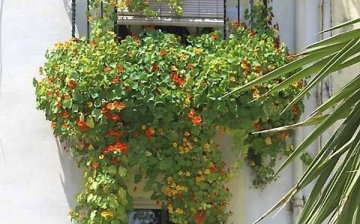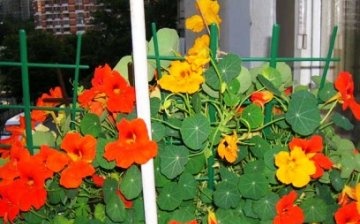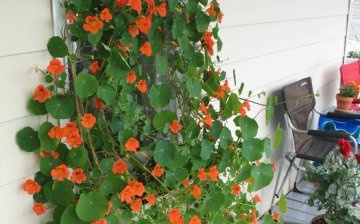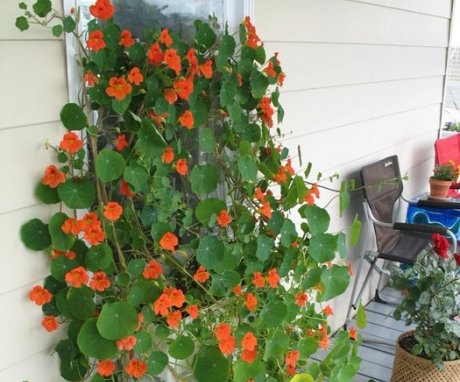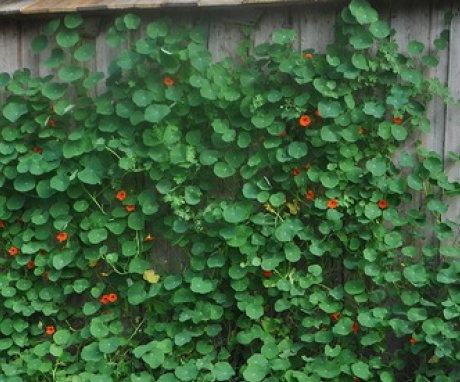Curly nasturtium in the photo pleases the eye and heart
Many flowers, which seem familiar to us from childhood, delight and surprise for many years. Those plants, which we, at times, do not even pay attention to and do not consider them necessary in our own flower garden, make us look at them differently, if we just want to. For example, this applies to curly nasturtium, shown in the photo.
Content:
- Nasturtium, its features and preferences
- Planting and reproduction of nasturtium
- Application of nasturtium
What seems to be more commonplace than nasturtium... Already we are used to seeing her from kindergarten, where nasturtium grows everywhere, not requiring special care, not allowing weeds to fill the flower bed, serving as an unassuming flower bed decoration. But it turns out that nasturtium is a real beauty. And all the more this applies to curly nasturtium.
Nasturtium, its features and preferences
This plant is an annual, planted on balconies, along fences or arbors. Nasturtium grows rapidly, reaching a length of three meters in lashes. Watering and feeding will make the curly nasturtium a real beauty. Its rounded bright green leaves will weave a real carpet, decorated with large enough flowers in shades of the sun - yellow, orange and reddish.
Curly nasturtium is absolutely not demanding on leavinglike regular nasturtium. But, of course, she gratefully responds to even minimal attention to her.
Conditions required for nasturtium:
- Location.
Nasturtium prefers open, sunny places. With a lack of light, it can begin to fade.
- The soil.
The best option is moderately fertile and light the soil, in which water will not stagnate. With an excess of moisture, rotting of the root system may begin. Also, nasturtium absolutely does not tolerate the presence of fresh manure in the soil.
- Watering.
Watering nasturtium needs moderate, but regular. It may be slightly more abundant during the initial growth of the plant. When flowering, watering is reduced again. From time to time, especially if nasturtium is grown at home, the surface of its leaves can be sprayed to maintain moisture levels.
- Top dressing.
Before the flowering period, nasturtium must be fed with complex mineral fertilizers. The plant reacts especially well to top dressing phosphorus and potassium. It will be enough to make them once a month. During the flowering period, top dressing is not needed, as it can provoke the growth of nasturtium leaves, and not its flowers.
- Possible diseases and pests.
Occasionally, there may be an infection of the plant with ring spot, rust, mosaic, gray mold, and heterosporiosis. Possible pests are aphids and miner flies. The solution to such problems is the use of an insectoacaricide.
Planting and reproduction of nasturtium
Curly nasturtium can be planted as seedlings, and seeds directly into the ground. Since the plant is thermophilic, early planting in open ground can be detrimental. Therefore, they do this at the end of May so that she does not die from frost. If you want to plant greenery on your balcony or want to get early flowering, you can sow nasturtium on seedlings in April.
Before sowing nasturtium, it is recommended to first fill its seeds with warm water for a day (temperature approximately 30-40 degrees).After the seeds swell, they must be planted in nests of 3-4 pieces in each hole (the distance between the holes is about 25 cm). Seeds of nasturtium hatch quickly, starting to grow. This happens in about two weeks. The first flowers appear 1.5 months after the shoots appear. Nasturtium blooms until frost.
Since nasturtium does not tolerate transplanting due to its superficial and fragile root system, it is best to grow seedlings in cups with a slide-out bottom.
Pruning the nasturtium can be part of caring for it. It may be necessary to carry out such a procedure in the case of too abundant gardening of the plant, which negatively affects the flowering of nasturtium. As already mentioned, such an overgrowth occurs due to excessive feeding and too abundant watering. If these reasons are not eliminated, the nasturtium will have to be pruned quite often.
Nasturtium is propagated using seeds, as well as using seedlings and cuttings. In addition, the plant is capable of setting a sufficiently large number of seeds that are able to overwinter in the ground after they begin to crumble.
Application of nasturtium
It is noteworthy that such a plant we are used to as nasturtium can be beautiful and useful, because young leaves and stems of nasturtium, rich in vitamin C, are used in salads, and the fruits are pickled like capers. Seeds, dried and milled, are a unique seasoning for many dishes.
Nasturtium is a medicinal plant that helps with vitamin deficiency, anemia, bronchitis, skin rashes and kidney stones. It is even used to stimulate hair growth.
So, nasturtium is an unpretentious and very beautiful plant. Good luck in growing it!



